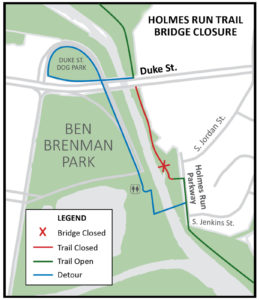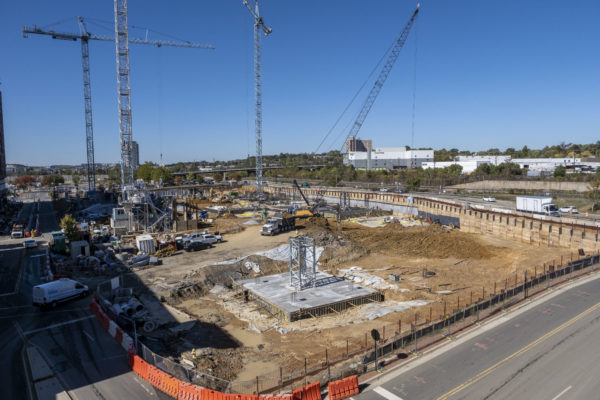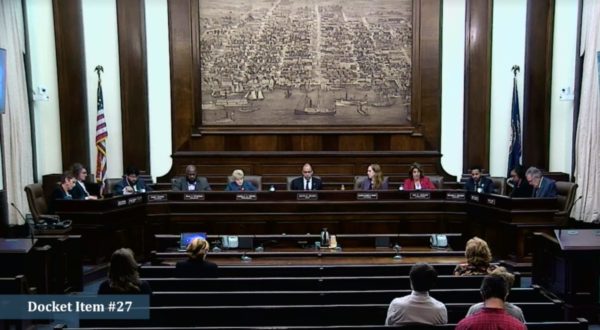Want a happy hour but don’t want to skip the gym? One Alexandria brewery has you covered.
Today (Wednesday) Aslin Beer is teaming up with running store Pacers to host an evening jog and social mixer for who those who like their exercise with company and beer.
The run will roll out at tonight, November 13, at the Aslin Beer Company (847 S. Pickett Street) in the Van Dorn neighborhood from 7-9 p.m. Runners will trek from Pickett Street, to S. Van Dorn Street and Eisenhower Ave, and back.
Participation is free, though runners are encouraged to mark that they’re interested in attending on Facebook.
Participants must be 21 years or older, and are invited to stick around after the run for drinks and socializing at the craft brewery.
The World Series wasn’t just a win for the Nats — it was also a boon for Alexandria’s water taxis.
The aquatic commute route was hailed as a “super-secret” way to dodge World Series crowds, and company officials said hundreds did ferry their way to Navy Yard — capping a season of growth for the service.
“During the recent World Series weekend, we operated three special ‘Baseball Boats’ between Alexandria City Marina and Diamond Teague carrying around 450 people to each home game,” said Nicola McShane, a spokeswoman for the Potomac Riverboat Company’s parent company, Hornblower Cruises and Events.
Water taxi tickets for the home games from Alexandria sold out last Saturday, October 26, though the company was still selling some from the Wharf.
The baseball boats from Alexandria to The Nationals stadium for tonight’s game are sold out. However, you can still take a water taxi from The Wharf to the Stadium (taxis will run until 8pm). Get on board, it’s time to #FinishTheFight!https://t.co/FpSMFNyp1D pic.twitter.com/TgGw2cxfVQ
— Potomac Riverboat (@prcwashingtondc) October 26, 2019
In March, the Potomac Riverboat Company, which runs the water taxis, announced it would run river trips during all home games for the Nats and D.C. United, reported Patch.
The company also added four new boats to its fleet, which helped add seven trips between 6:40-9:20 a.m. on weekdays in preparation for the Metro’s station repair projects that shuttered multiple stations this summer.
But in August after the shutdown ended, Mayor Justin Wilson announced the service was so popular the city was asking the Riverboat company to continue running extended service through the end of the year, and is due to vote on loosening regulations next year to make the new scheduled permanent.
“I am optimistic that this success will provide an opening to make the use of our water as a viable commuting option, a permanent feature for our community,” said the mayor.
The ridership bump may have been in part because the City of Alexandria offered to reimburse water taxi commuters for their fares. In total, the city spent $28,214 reimbursing the fares with $5,642 from the city’s budget, and the rest from a state transportation grant, according to Sarah Godfrey, spokesman for the Department of Transportation & Environmental Services.
But commuters also praised the taxis’ fresh air, food and drinks, and lack of crowds when traveling on the Potomac (though the river poses its own risks.)
Perhaps surprisingly in Old Town, where parking issues run rampant, Godfrey noted the city did not receive any parking complaints this summer as more people than ever boarded the water taxis.
“We do not collect parking data directly, but both [Potomac Riverboat Company] and our own survey of those seeking reimbursement suggests most users walk to the water taxi,” she told ALXnow. “In fact, 78 percent of those who sought our reimbursement either walked or biked to the water taxi.”
The total ridership for 2018 was “over 250,000”, according to the CEO Kenneth Svendsen, who previously told Patch it was the company’s “best-ever performance to date.”
McShane declined to share the company’s overall 2019 ridership numbers with ALXnow, but noted that “we have seen a significant increase in guests using our services to navigate and explore the wider metropolitan area when compared to last year. This demonstrates there is a real, and growing appetite for water taxi transport.”

(Updated at 12 p.m.) A bald eagle rescued on Metro tracks has died — but not before revealing something interesting.
The eagle died earlier this week after being rescued near the Van Dorn Metro station tracks and rushed to the Blue Ridge Wildlife Center in Boyce, Virginia. His broken wing was a deep fracture down to the bone, and it was located too close to his elbow to ever heal properly, said service providers at the wildlife hospital.
But Blue Ridge staff said blood tests from the bird were a surprise.
“It’s actually our first eagle in three years not to have lead in its system,” said Dr. Jen Riley, the hospital’s director of veterinary services. “We test every single bald eagle that comes in because they tend to have very high lead levels.”
Riley told ALXnow that eagles are primarily scavengers and often absorb lead by eating dead animals shot with lead bullets. “There are huge amounts of lead in Virginia because we have such a huge hunting population,” she noted.
In the past, some eagles rescued in the area have had faced long recoveries from lead poisoning, among other injuries. Riley said finding an eagle with no lead in his body probably meant he was frequently fishing in the Potomac River.
“There’s definitely an awesome population of eagles near the Potomac, but that implies they have pretty good food there,” she said of the lead test.
D.C. has sunk billions into cleaning up its long-polluted waterways, and there are signs it may be paying off: scientists are spotting more dolphins downstream, and some hope it will be clean enough for humans to swim in soon. An eagle being able to regularly fish from the water may be another good sign — but Riley cautioned that a fish shortage might then have driven the bird to seek other prey.
“They probably just have a good amount of dead mice or rats along Metro tracks,” she said of her guess why two eagles this year have been found near the tracks. “Raptors in general are on our roads for that reason.”
Both raptors were transported to the National Eagle Repository, which collects deceased eagles for Native American ceremonies. The program is part of the Bald Eagle Protection Act, dating back to the 1940s, that restricts who can and cannot care for eagles and keep parts, like feathers. Although the eagle populations have rebounded since the country stopped using the notoriously deadly pesticide DDT, the federal protections remain in place today.
Riley said anyone who finds an eagle should contact their local animal control, and if they’re not sure who that is, they can contact state wildlife hospitals like Blue Ridge, which will help them find the right person to help.
The City of Alexandria could be restricting noise limits citywide, and double violations fines as part of new ordinances.
City staff are proposing a citywide noise limit of 65 decibels (about the volume of a normal conversation) in a public place within 10 feet of a structure, and nothing louder than 75 decibels (about the volume of an average dishwhasher) in a public place within 50 feet of a structure.
Previously, those limits only applied to Alexandria’s Central Business District.
In a presentation shared with residents, officials note that the existing 53-year-old noise regulations on the books are long overdue for an update. The old rules don’t include information about loading times for delivery trucks and measuring noise across property lines, for example.
Now staff are proposing several updates, including:
- A loading truck ban from 11 p.m. to 7 a.m. every day.
- A quiet hours designation for “plainly audible sound” in residential areas, from 11 p.m.-7 a.m.
- Limiting the hours of outdoor cleaning equipment (like power washers) to match the hours set aside for lawn equipment: 7 a.m.-9 p.m. on weekdays, and 9 a.m.-9 p.m. on weekends.
- Limiting pet noise: nothing audible from neighboring houses for more than five minutes during the day, or anytime at night if the barking (or other animal noise) is audible to neighborhoods with closed windows and doors closed.
The proposed changes would also double the existing penalties for breaking noise ordinances: from $50 to $100 for the first violation, $100 to $250 for the second violation, and $250 to $500 for the third violation.
However, the new regulations would keep several, long-standing exemptions, including aircraft noise which residents have long protested, as well as Metrorail trains and road work.
Any changes in Alexandria will require approval from the City Council before going into effect. The city is currently accepting comments about the proposed changes.
“We’re in the middle of a public outreach process,” said Department of Transportation & Environmental Services spokeswoman Sarah Godfrey. “Once we review all comments, we’ll address those raised before submitting a final revision to Council for consideration. We expect to go to Council early next year.”
Godfrey said the recommended increase in fines is based what other nearby jurisdictions impose.
“The current fines are outdated,” she told ALXnow. “We looked at the fine structures of our neighboring jurisdictions and worked to come up with comparable, reasonable amounts.”
Staff are also proposing to create a new noise institutional zoning category of noise regulations, to cover schools, public buildings, and places of worship that fall outside the city’s other, existing categories (residential, commercial, and industrial.) Properties that fall under this new category could allow a higher threshold for noise (65 decibels) than residential properties (55 decibels), but lower than industrial areas (70 decibels.)
 (Updated at 12:25 p.m.) Alexandria has closed a pedestrian bridge along Holmes Run after a safety inspection found the structure needed “immediate repair.”
(Updated at 12:25 p.m.) Alexandria has closed a pedestrian bridge along Holmes Run after a safety inspection found the structure needed “immediate repair.”
The bridge that spans from Ben Brenman Park to Holmes Run Parkway was shut down late last week, according to city officials.
“During routine park amenity inspection by staff from the Department of Recreation, Parks and Cultural Activities, it was found that the bridge footings were unstable due to soft soil and loose rock below the footing,” the city said in a statement.
“An inspection by a civil engineer from the Department of Transportation & Environmental Services deemed the bridge to require immediate repair to ensure pedestrian safety,” city officials added.
For now, pedestrians will be able to follow signs for a detour route that crosses Holmes Run at the footbridge just south of the stream from the Holmes Run playground. This temporarily route links to back to Holmes Run Trail as it heads north towards Duke Street.
Image 1 via Google Maps

(Updated 2:30 p.m.) Work on the new Wegmans in Alexandria is progressing as construction crews dig downwards.
Cranes and workers could be seen on the site near the Eisenhower Metro today (Thursday) that now resembles a five-acre dug-out after construction on the future $400 million mixed-use development kicked off in August, as reported by Alexandria Living Magazine.
The so-called “Caryle Crossing” development complex is slated to reach as high as 18 stories and include an 85,000-square-foot Wegmans as well as 210,000-square-feet of retail space, and 750 housing units, per the Washington Business Journal. The residential units to be included in the complex at the corner of Mandeville Lane and Stovall Street will be a mix of condos (30), senior housing units (200), and apartments (400.)
Wegmans is expected to occupy the second floor of the building complex, though the grocer remains mum on the specifics.
“We are currently working on the internal store design and will begin construction once Stonebridge turns over the space to us, which is still several years out,” a spokeswoman for the Wegmans grocery chain company told ALXnow.
Alexandria originally gave developer Stonebridge Carras the green light for the project last year, and since then the company has pivoted from building mostly condos to multi-family apartments on the site, according to Patch. The timeline given for completion was originally 2021, but by August the developer was reporting construction would likely last until 2022.
Stonebridge did not respond to a request from ALXnow for more information about the construction work in time for publication.
“This project will provide critical retail and services to boost the quality of life for everyone who works and lives here and deliver some of the best amenities anywhere in Alexandria,” Mayor Justin Wilson told the Business Journal in July.
Alexandria’s Rock the Block event allowing participants to sample choice dishes and drinks is returning this year and is expecting more restaurants, and bigger crowds.
The “choose-your-own culinary adventure” event will return to Old Town on Thursday, November 7, 2019 from 6-9 p.m., per its website. Restaurants will welcome roaming attendees throughout the night with 5-6 small plate dishes and 3-4 speciality cocktails.
“Capitalizing on the success of the 2018 inaugural year, several of Old Town’s hottest restaurants will again close their doors to the public for this signature event, serving up some delectable dishes and specialty cocktails,” organizers wrote in a press release. “Individuals will receive a wristband and a map in which they can choose their own culinary tour by selecting their starting restaurant from the participating restaurants.”
General Admission tickets cost $125 and allow buyers to sample food and drinks at the Old Town restaurants. VIP tickets cost $300 and cover the samples as well as a private reception with special guests and and an after-party with desserts, signature cocktails, and dancing.
Twelve restaurants will participate in this year’s event, including:
- Augie’s Mussel House
- Urbano 116
- The Majestic
- Vermilion
- Whiskey & Oyster
- Columbia Firehouse
- Joe Theismann’s Restaurant and Bar
- Mia’s Italian Kitchen
- Pizzeria Paradiso
- Tequila & Taco
In addition to the restaurants, an event spokeswoman noted that the event will feature “a culinary pop-up at the Charles Schwab headquarters with Sweet Fire Donna’s Barbecue and Alexandria’s own cidery Lost Boy Cider.”
Last year’s event attracted around 500 people, and this year’s is expected to bring up to 800, per organizers.
The Ramsey Homes affordable housing project will loaned an additional $1.4 million thanks to a vote by the Alexandria City Council.
Council members voted to grant the additional funding to the redevelopment last night (Tuesday), bringing the total amount Alexandria has loaned to $5 million.
The long-awaited, sometimes contentious project aims to replace 15 public housing buildings with 52 affordable housing units on the Braddock site. Of the new units, 37 will be reserved for households earning up to 60% of the area’s median income ($56,022) and 15 units set aside for households earning 30% or less than the median income ($28,011.)
“We’re delighted that the City Council is continuing to show strong support for the project,” Helen McIlvaine, the city’s head of housing, told ALXnow after the vote. “It’s going to replace units that had to come down because they’re dilapidated but it’s also going to add new units.”
The Alexandria Redevelopment and Housing Authority (ARHA) is developing the property at the corner of N. Patrick and Wythe streets and requested the money after CEO Keith Pettigrew said last year’s unusually wet weather delayed the archaeological study the city requires as part of the construction site review.
“The unexpected costs associated with the four months of dewatering for archeology had not been accounted for in our pre-development budget,” noted Pettigrew.
“Every time they resumed the archeological work it would rain again so I think they just remained behind the 8-ball,” said McIlvaine. “I understand that they were de-watering systems that might have been more efficient in other projects so maybe that’s a lesson that we would learn.”
“But most of what has occurred here was an external issue and we’re all trying to make sure the project stays on track,” she added.
Pettigrew attended the City Council meeting, but did not comment.
This is the second time the City Council has increased the loan to ARHA. Council members increased it by $1.6 million last May, as reported by the Alexandria Times, after ARHA cited rising construction costs and the loss of a tax credit.
The same document noted that “the ARHA team managing the project currently does not include any of the original staff who have transitioned out of the agency since the development was first approved and funded.”
Mayor Justin Wilson said he was “happy” to have the staff members there and thanked them for their hard work.
“I know that this has been a challenge from the beginning, from even before you got here,” he said. “I know it’s something you inherited.”
The $1.4 million will come out of previous ARHA loan repayments to the city, and agency staff noted in a Council memo they plan to pay it back in 2035.
(Updated at 3:20 p.m.) While Alexandria heads out on ghosts tours for Halloween, local archaeologists are busy scouting for secret burials under two historic cemeteries.
Archeologists with the city’s Office of Historic Alexandria are working to pinpoint where coffins and headstones may have been swallowed by the changing landscaping in the Penny Hill and Douglass cemeteries as they plan drainage maintenance for the sites.
“In a couple places you see the very tippy tops of headstones just barely peeking above the dirt and you realize that there’s an entire headstone sunken in 2-3 feet. So you look around and go ‘Oh my god this entire cemetery is slowly sinking into the ground,'” Benjamin Skolnik, an archeologist with the city, told ALXnow of the issues facing the two cemeteries.
“A lot of the markers were probably made of wood and have since decayed and evaporated into the mists of time,” he said, adding that others buried in the Penny Hill potter’s field often couldn’t afford a marker.
Fixing the drainage issues at both sites causing could mean digging ditches — and right now that would be impossible without disrupting lost burial sites.
Penny Hill was founded in 1796 but start records only date back to 1912. Those records indicate 906 people were buried in the last century, but today cemetery is an empty, grassy field.
And at Douglass, where records indicate the first person was buried in 1895, there are about 650 standing headstones, but over 1900 names recorded in burial records.
“There’s three times the number of people written in the cemeteries as there are standing headstones, so the question is where is everybody?” said Skolnik.
This summer, the state awarded Alexandria a $10,500 grant to study what graves could be underneath the grass at both cemeteries. Now the survey work is underway as teams of archeologists rove the grounds with ground-penetrating radar (the same kind used to find dinosaurs) and electrical conductivity meters to identify burials by the metal hinges on caskets, the shafts dug to bury caskets, as well as skeletal remains or headstones.
Initial data from Douglass confirms some areas with no standing stones do have graves underneath, and in some cases, more than one grave.
“We know that they were selling what they referred to as “half-graves” which is basically that you stack them,” explained Skolnik. “The first one goes down 8 feet. The next one goes down 4 feet.”
The surveys haven’t gone without a hitch, however. Yesterday (Tuesday’s) rain storm cancelled one day of work, and nearby utilities can interfere with the equipment.
“We ran into a small problem on Saturday when we started our survey at Penny Hill,” said Skolnik. “The southeast corner of Penny Hill is right next to a power substation [which] was playing havoc with the sensitive instruments.”
The surveys are in addition to the Alexandria archaeologists’ other responsibilities, including examining possible remains and objects buried under development sites — work that led to the excavation and reconstruction of several long-buried ships.
“It’s probably not a surprise that there are lot of archeology resources in Alexandria,” said Skolnik. “There’s a lot going on under the ground.”

The Alexandria City Council reaffirmed longstanding rent increase guidelines after debating the value of the unenforceable rules.
Last night (Tuesday), City Council members voted in favor of keeping guidelines capping rent increases at 5%, but not before arguing over the point of the “symbolic” guidelines, with one member jokingly offering to lower the cap to 1%.
“The question is why, when we have no authority, are we publishing a number that gives people some suggestion that we do authority, when we don’t,” said Mayor Justin Wilson. “We could pick any number here and we’re still going to be in these same position.”
For three decades, the city has issued Voluntary Rent Guidelines suggesting landlords not raise rents too high in a given year, and has issued caps as low as 5% and as high as 9%. However, the city has no way of legally enforcing the cap as Virginia lacks rent control laws. Instead, city staff negotiate with landlords to convince them to voluntarily stick to the cap, a difficult process Alexandria Times has previously reported on.
Alexandria Housing Division Chief Melodie Seau told ALXnow that the negotiations work about half the time.
“Hopefully with the upcoming election we’ll be able to able to implant some sort of rent control if not locally, then by the state, but that’s is big picture,” said Councilman Mohamed “Mo” Seifeldein, referring to the progressive agenda some Virginia Democrats have promised to enact if they win control over Richmond next month.
For now, Seifeldein argued the city’s non-binding guidelines meant Alexandria could and should lower the cap to 3% to help renters. He cited the need to be more aggressive in preserving affordable housing in light of recent warnings about regional housing shortfalls and Arlington and Alexandria’s recent team up to discuss how to prevent Amazon from pricing people out of the region.
“But the thing is that it doesn’t have any teeth,” Councilman Canek Aguirre replied, who said they might as well lower it to 1% if this was about proving “political will.”
Seifeldein agreed, and replaced his 3% proposal with Aguirre’s 1% one.
Councilman John Taylor Chapman echoed the sentiment, said he believed the council was “stretching to make a symbol of this because we want to show that we have political will on housing.”
“I would rather put some people in a unit and get some money like we did with Ramsey Homes, not making a statement on a resolution that has no teeth to symbolize to the public that we’re doing something,” said Chapman, referring to the delayed and over-budget affordable housing development in Braddock.
Members voted 1-5 against Aguirre’s motion for a 1% cap, killing it, along with Seifeldein’s original 3% proposal. Seifeldein abstained from voting.
The resolution considered by the council last night notes that rent hikes pose a growing problem:
Prior to 2000, very few Alexandria landlords with properties of 10 or more rental units failed to comply with the City’s Voluntary Rent Guidelines. However, noncompliance increased significantly around 2,000, when the vacancy rate for rental properties in the city dropped below 1%, and again in 2005 when a large number of rental units were converted to condominiums and rents increased throughout the D.C. metropolitan area.
“It used to be be back the 80s they didn’t have all these software programs that would develop rents on a daily, sometimes hourly, basis,” said Seau. “Property management doesn’t have the ability to override the recommendation from whatever system they’re using.”
Seifeldein noted on the dais that he didn’t want to “dignify” the misrepresentations to his original 3% motion, but did want “loosely quote” Congresswoman Ayanna Pressley (MA-D) that “those closest to the pain should be making the decisions.”
The council ultimately voted 6-0 to approve the originally-proposed 5% rent cap, with Seifeldein abstaining.
Image via the City of Alexandria

